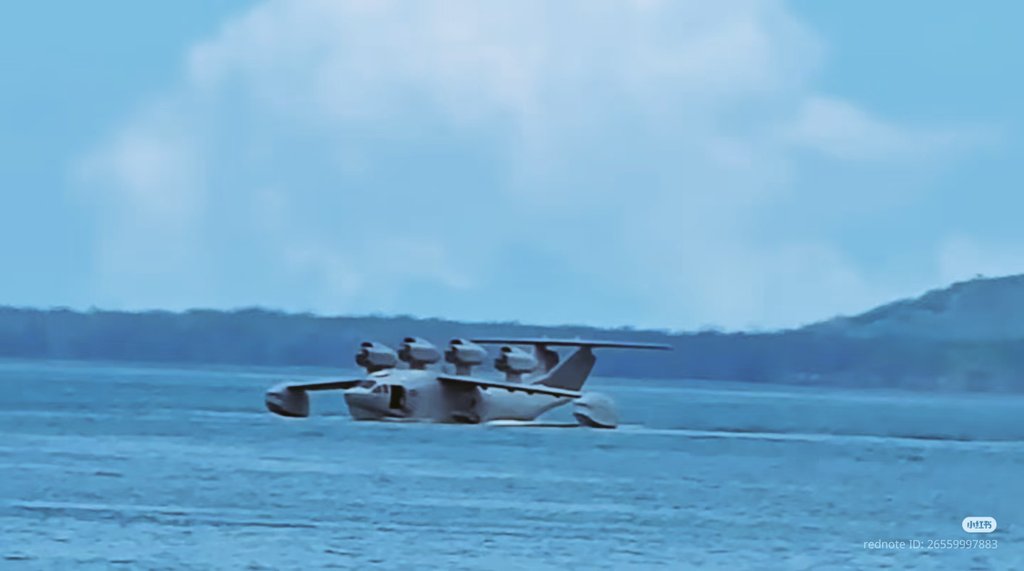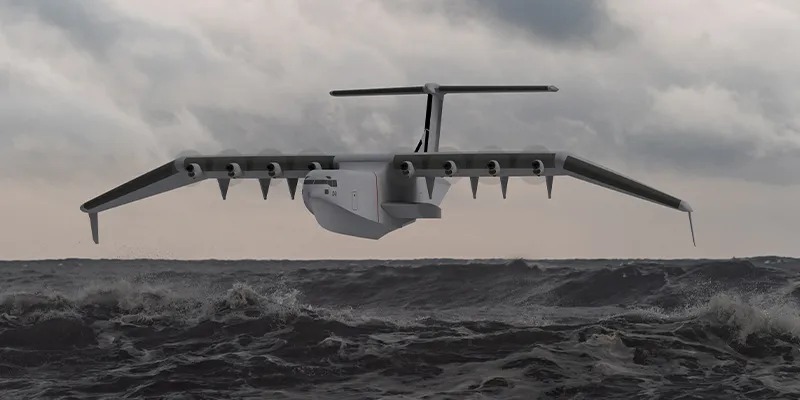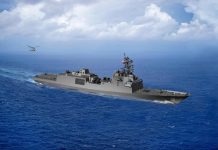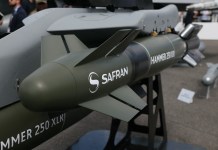China appears to have developed a mammoth, brand-new Ekranoplan, popularly known as flying boats, decades after the Soviet Union first invented the technology during the Cold War.
The mysterious Ekranoplan first appeared on Chinese social media last week, with Open Source Intelligence (OSINT) and naval analyst H.I. Sutton initially drawing attention to it.
It was first seen in a picture with part of its nose hidden. The image showed the flying-boat-hulled aircraft perched on a pier in the Bohai Sea, which is located at the northwest tip of the Yellow Sea.
Sutton casually referred to it as ‘Bohai Sea Monster’, insinuating that it was a Chinese vessel modelled after the popular Soviet ‘Caspian Sea Monster,’ the first-ever Ekranoplan introduced to the world in the 1960s.
Chinese authorities have not disclosed the name, designation, or manufacturer of the massive Ekranoplan. However, we know that it is nearly comparable in size to the AG600, the world’s largest amphibious aircraft, which has been designed to carry out operations such as search and rescue and resupply missions over the sea.
What Is An Ekranoplan?
Ekranoplans are also known as Ground Effect Vehicles, a hybrid between airplanes and ships. Simply put, they move over water without actually touching it.
An Ekranoplan is a specialized vehicle that operates using the wing-in-ground effect (WIG), allowing it to skim just above the surface of water (typically 1–5 meters) at high speeds.
It combines features of an aircraft and a ship, leveraging the aerodynamic principle of ground effect, where lift is increased and drag is reduced when flying close to a surface.
They take advantage of an aerodynamic principle called the “ground effect.” They fly low to exploit this effect, achieving speeds of 300–500 kilometers per hour (kph), which is significantly faster than most ships but slower than a typical aircraft.
Additionally, their proximity to the surface while flying makes them difficult to detect by radar. Thus, allowing them to exploit the deadly combination of stealth and speed.
They are also immune to underwater threats, such as submarines, mines, or torpedoes, because they don’t come into contact with the water’s surface and cause minimal sonar disruption.
Even achieving torpedo strikes would be challenging since their airframes do not touch the water, while torpedoes travel just under the surface.
Ekranoplans could be powered by jet engines, turboprops, or hybrid propulsion, and feature configurations such as catamarans or high T-tails for enhanced stability. As evident by their name, they can operate from water or makeshift runways, making them ideal for amphibious or island-based operations.
The Chinese Ekranoplan has a unique T-tail configuration with two vertical stabilizers on a flying boat hull. Typically, these aircraft are known for having long tails and very short wingspans. This craft is powered by four engines seen above the wings, and is designed to operate entirely above the water.
Some reports have noted that the nose is a notable feature, as it appears to be designed for efficiency.

As of now, it’s unknown whether this design is merely a technology demonstrator or if there’s a genuine attempt to put a craft like this into full-scale manufacturing.
However, it is believed that this new design could be positioned as a vessel designed for conducting missions such as resupply, rapid transport, and search and rescue operations, much like the AG600.
It may also have a military application, as hinted by the grey paint scale in which it was photographed. The vessel could be used in a potential conflict in the Taiwan Strait or the contested South China Sea, where Beijing has built and militarised multiple artificial islands.
That said, while the new design has piqued global interest, China is not the only one to have developed an Ekranoplan. As previously reported by the EurAsian Times, the US Defense Advanced Research Projects Agency (DARPA) awarded the first phase of its Liberty Lifter Ekranoplan program to Aurora Flight Sciences (AFS).
Phase 1 of the DARPA Liberty Lifter program “aimed to design, build, float, and fly an affordable X-plane that demonstrates revolutionary heavy-air-lift capability from the sea,” as noted by the contractor at the time. As per the plan, the firm was to be funded for six months to “reach conceptual design review of a wing-in-ground-effect seaplane.”

Aurora’s concept is a “high-wing monohull seaplane designed for affordable full-scale production and extended maritime operations, including at high sea states and in high-traffic areas.” The concept would employ “a robust and adaptive control system designed to meet the challenge of operations to and from the sea surface and at low altitude around waves and obstacles,” the statement added.
This project now stands cancelled!
However, much before the Chinese and American, there was the Soviet Ekranoplan—the very first in the world—that helped lay the groundwork for further innovation and modernization of the concept.
The Soviet ‘Caspian Sea Monster’
Soviet designer Rostislav Alexeyev pioneered the development of Ekranoplans, with the former Soviet Union leading the technology during the Cold War and developing multiple such designs.
The first Soviet Ekranoplan was the “Caspian Sea Monster.” At 302 feet long, with a 1,199,315-pound takeoff weight and 10 Dobrynin VD-7 turbojets, it was a massive experimental ekranoplan and the largest “aircraft” of its time until 1988.
The Caspian Sea Monster was used for testing on the Caspian Sea but crashed in 1980 and sank. The crash was attributed to pilot error.
Following this, the Soviets developed the “Lun,” which was designed by Rostislav Evgenievich Alexeyev and was used by the Soviet and then Russian Navy from the late 1980s to the late 1990s. It was powered by eight Kuznetsov NK-87 turbofans mounted on canards, kicking out 127.4 kilonewtons (kN) of thrust each.
The vessel had a flying boat hull and a sizeable deflecting plate at the bottom to provide a “step” for takeoff. It had a maximum cruising speed of around 550 kilometers an hour.
It was designed for anti-surface warfare, designed to attack NATO warships, including aircraft carriers, with stealth and speed. It carried P-270 Mosquito-guided missiles, housed in six missile launchers mounted in pairs on the dorsal surface of the fuselage. It was guided using surveillance and tracking systems located on the nose and tail.
The Soviets built only one model of this class, the MD-160, which entered service in the Black Sea Fleet in 1987. It was later retired in the 1990s. The Russians planned another version for rapid deployment as a mobile field hospital, but it was never completed due to funding cuts.
The Lun-class MD-160, once a symbol of Soviet innovation, is now a museum piece, stranded near Derbent since 2021. Its beaching and damage during transport sparked media attention and public fascination.

There were other designs too, but none as consequential as the two listed above.
In 2017, Russia announced the development of another modern ekranoplan, the Chaika A-050. It was intended for multi-role use, with a displacement of approximately 54 tons, a speed of 450 kilometers per hour, a range of 5,000 kilometers, and a capacity for about 100 passengers or fighters.
It was slated for operation by 2022 and anticipated for patrol deployment at the Northern Sea Route, Black Sea, and Caspian Sea, potentially armed with missiles.
The US first detected Soviet ekranoplans in the 1960s via satellite imagery, notably the “Caspian Sea Monster” (KM). By the 1980s, the Lun’s capabilities alarmed NATO, prompting analysis of its potential to disrupt naval operations.
It countered them indirectly through enhanced naval defenses and intelligence. Following the dissolution of the Soviet Union, the concept began to fade away. However, it is now experiencing a resurgence, with all major players set to field their flying boats.
- Contact the author at sakshi.tiwari9555 (at) gmail.com
- Follow EurAsian Times on Google News




